This is an old revision of this page, as edited by 24.178.45.221 (talk) at 05:56, 8 June 2015 (→Religion: reduction and simplification). The present address (URL) is a permanent link to this revision, which may differ significantly from the current revision.
Revision as of 05:56, 8 June 2015 by 24.178.45.221 (talk) (→Religion: reduction and simplification)(diff) ← Previous revision | Latest revision (diff) | Newer revision → (diff) This article is about the country. For other uses, see Switzerland (disambiguation).| Swiss Confederation | |
|---|---|
 Flag
Flag
 Coat of arms
Coat of arms
| |
| Motto: (traditional) "Unus pro omnibus, omnes pro uno" (Latin) "One for all, all for one" | |
| Anthem: "Swiss Psalm" | |
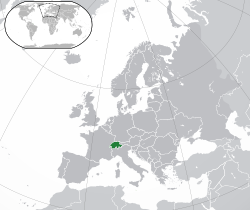 Location of Swizerland (green) Location of Swizerland (green)in Europe (green & dark grey) | |
| Capital | None (de jure) Bern (de facto) |
| Largest city | Zürich |
| Official languages | German; French; Italian; Romansh |
| Demonym(s) | Swiss |
| Government | Federal multi-party directorial republic with thorough elements of direct democracy |
| • Federal Council | |
| • Federal Chancellor | Corina Casanova |
| Legislature | Federal Assembly |
| • Upper house | Council of States |
| • Lower house | National Council |
| History | |
| • Foundation date | c. 1300 celebrated on 1st August 1291 |
| • Treaty of Basel (1499) | 22 September 1499 |
| • Peace of Westphalia | 24 October 1648 |
| • Restauration | 7 August 1815 |
| • Federal state | 12 September 1848 |
| Area | |
| • Total | 41,285 km (15,940 sq mi) (135th) |
| • Water (%) | 4.2 |
| Population | |
| • September 2014 estimate | 8,211,700 (96th) |
| • 2013 census | 8,139,600 |
| • Density | 198/km (512.8/sq mi) (65th) |
| GDP (PPP) | 2015 estimate |
| • Total | $480.938 billion (39th) |
| • Per capita | $58,731 (9th) |
| GDP (nominal) | 2015 estimate |
| • Total | $688.434 billion (19th) |
| • Per capita | $84,070 (2nd) |
| Gini (2011) | 29.7 low inequality |
| HDI (2013) | very high (3rd) |
| Currency | Swiss franc (CHF) |
| Time zone | UTC+1 (CET) |
| • Summer (DST) | UTC+2 (CEST) |
| Date format | dd.mm.yyyy (AD) |
| Drives on | Right |
| Calling code | +41 |
| ISO 3166 code | CH |
| Internet TLD | .ch |
| Website http://www.admin.ch | |
Switzerland (/ˈswɪtsərlənd/; Template:Lang-de Template:IPA-de; Template:Lang-fr Template:IPA-fr; Template:Lang-it Template:IPA-it; Template:Lang-rm [ˈʒviːtsrɐ] or [ˈʒviːtsʁːɐ]), officially the Swiss Confederation (Template:Lang-la, hence its abbreviation CH), is a federal parliamentary republic consisting of 26 cantons, with Bern as the seat of the federal authorities, the so-called Bundesstadt ("federal city"). The country is situated in Western and Central Europe, where it is bordered by Italy to the south, France to the west, Germany to the north, and Austria and Liechtenstein to the east. Switzerland is a landlocked country geographically divided between the Alps, the Swiss Plateau and the Jura, spanning an area of 41,285 km (15,940 sq mi). While the Alps occupy the greater part of the territory, the Swiss population of approximately 8 million people is concentrated mostly on the Plateau, where the largest cities are to be found; among them are the two global and economic centres of Zürich and Geneva.
The establishment of the Swiss Confederation is traditionally dated to 1 August 1291, which is celebrated annually as Swiss National Day. The country has a long history of armed neutrality—it has not been in a state of war internationally since 1815—and did not join the United Nations until 2002. Nevertheless it pursues an active foreign policy and is frequently involved in peace-building processes around the world. In addition to being the birthplace of the Red Cross, Switzerland is home to numerous international organizations, including the second largest UN office. On the European level, it is a founding member of the European Free Trade Association and is part of the Schengen Area – although it is notably not a member of the European Union, nor the European Economic Area (and thus does not use the Euro currency).
Straddling the intersection of Germanic and Romance Europe, Switzerland comprises four main linguistic and cultural regions: German, French, Italian and Romansh. Therefore, the Swiss, although predominantly German-speaking, do not form a nation in the sense of a common ethnicity or language; rather, Switzerland's strong sense of identity and community is founded on a common historical background, shared values such as federalism and direct democracy, and Alpine symbolism.
Switzerland ranks high in several metrics of national performance, including government transparency, civil liberties, economic competitiveness, and human development. In April 2015, Switzerland was found to be the ‘happiest’ country in the world in the third annual World Happiness Report. It has the highest nominal wealth per adult (financial and non-financial assets) in the world according to Credit Suisse and the eighth-highest per capita gross domestic product on the IMF list. Zürich and Geneva each have been ranked among the top cities with the highest quality of life in the world (the former coming second globally according to Mercer).
Etymology
Main article: Name of SwitzerlandThe English name Switzerland is a compound containing Switzer, an obsolete term for the Swiss, which was in use during the 16th to 19th centuries. The English adjective Swiss is a loan from French Suisse, also in use since the 16th century. The name Switzer is from the Alemannic Error: {{Lang}}: unrecognized language code: gsx (help), in origin an inhabitant of Schwyz and its associated territory, one of the Waldstätten cantons which formed the nucleus of the Old Swiss Confederacy. The name originates as an exonym, applied pars pro toto to the troops of the Confederacy. The Swiss began to adopt the name for themselves after the Swabian War of 1499, used alongside the term for "Confederates", Eidgenossen (literally: comrades by oath), used since the 14th century.
The toponym Schwyz itself is first attested in 972, as Old High German Suittes, ultimately perhaps related to suedan "to burn", referring to the area of forest that was burned and cleared to build. The name was extended to the area dominated by the canton, and after the Swabian War of 1499 gradually came to be used for the entire Confederation. The Swiss German name of the country, Error: {{Lang}}: unrecognized language code: gsx (help), is homophonous to that of the canton and the settlement, but distinguished by the use of the definite article ( Error: {{Lang}}: unrecognized language code: gsx (help) for the Confederation, but simply Error: {{Lang}}: unrecognized language code: gsx (help) for the canton and the town).
The Latin name Confoederatio Helvetica was neologized and introduced gradually after the formation of the federal state in 1848, harking back to the Napoleonic Helvetic Republic, appearing on coins from 1879, inscribed on the Federal Palace in 1902 and after 1948 used in the official seal. It is derived from the name of the Helvetii, a Gaulish tribe living on the Swiss plateau before the Roman era. Helvetia appears as a national personification of the Swiss confederacy in the 17th century, with a 1672 play by Johann Caspar Weissenbach.
History
Main article: History of SwitzerlandSwitzerland has existed as a state in its present form since the adoption of the Swiss Federal Constitution in 1848. The precursors of Switzerland established a protective alliance at the end of the 13th century (1291), forming a loose confederation of states which persisted for centuries.
Early history
Main articles: Early history of Switzerland and Switzerland in the Roman eraThe oldest traces of hominid existence in Switzerland date back about 150,000 years. The oldest known farming settlements in Switzerland, which were found at Gächlingen, have been dated to around 5300 BC.
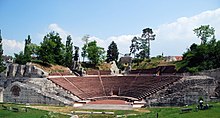
The earliest known cultural tribes of the area were members of the Hallstatt and La Tène cultures, named after the archaeological site of La Tène on the north side of Lake Neuchâtel. La Tène culture developed and flourished during the late Iron Age from around 450 BC, possibly under some influence from the Greek and Etruscan civilisations. One of the most important tribal groups in the Swiss region was the Helvetii. Steadily harassed by the Germans, in 58 BC the Helvetii decided to abandon the Swiss plateau and migrate to western Gallia, but Julius Caesar's armies pursued and defeated them at the Battle of Bibracte, in today's western France, forcing the tribe to move back to its original homeland. In 15 BC, Tiberius, who was destined to be the second Roman emperor and his brother, Drusus, conquered the Alps, integrating them into the Roman Empire. The area occupied by the Helvetii—the namesakes of the later Confoederatio Helvetica—first became part of Rome's Gallia Belgica province and then of its Germania Superior province, while the eastern portion of modern Switzerland was integrated into the Roman province of Raetia. Sometime around the start of the Common Era, the Romans maintained a large legionary camp called Vindonissa, now a ruin at the confluence of the Aare and Reuss rivers, near the town of Windisch, an outskirt of Brugg.
The first and second century AD were an age of prosperity for the population living along the Swiss plateau. Several towns, like Aventicum, Iulia Equestris and Augusta Raurica, reached a remarkable size, while hundreds of agricultural estates (Villae rusticae) were founded in the countryside.
In about 260 AD, the fall of the Agri Decumates territory north of the Rhine transformed today's Switzerland into a frontier land of the Empire. Repeated raids by the Alamanni tribes provoked the ruin of the Roman towns and economy, forcing the population to find shelter near Roman fortresses, like the Castrum Rauracense near Augusta Raurica. The Empire built another line of defense at the north border (the so-called Donau-Iller-Rhine-Limes), but at the end of the fourth century the increased Germanic pressure forced the Romans to abandon the linear defence concept, and the Swiss plateau was finally open to the settlement of German tribes.
In the Early Middle Ages, from the end of the 4th century, the western extent of modern-day Switzerland was part of the territory of the Kings of the Burgundians. The Alemanni settled the Swiss plateau in the 5th century and the valleys of the Alps in the 8th century, forming Alemannia. Modern-day Switzerland was therefore then divided between the kingdoms of Alemannia and Burgundy. The entire region became part of the expanding Frankish Empire in the 6th century, following Clovis I's victory over the Alemanni at Tolbiac in 504 AD, and later Frankish domination of the Burgundians.
Throughout the rest of the 6th, 7th and 8th centuries the Swiss regions continued under Frankish hegemony (Merovingian and Carolingian dynasties). But after its extension under Charlemagne, the Frankish empire was divided by the Treaty of Verdun in 843. The territories of present day Switzerland became divided into Middle Francia and East Francia until they were reunified under the Holy Roman Empire around 1000 AD.
By 1200, the Swiss plateau comprised the dominions of the houses of Savoy, Zähringer, Habsburg, and Kyburg. Some regions (Uri, Schwyz, Unterwalden, later known as Waldstätten) were accorded the Imperial immediacy to grant the empire direct control over the mountain passes. With the extinction of its male line in 1263 the Kyburg dynasty fell in AD 1264; then the Habsburgs under King Rudolph I (Holy Roman Emperor in 1273) laid claim to the Kyburg lands and annexed them extending their territory to the eastern Swiss plateau.
Old Swiss Confederacy
Main article: Old Swiss Confederacy Further information: Growth of the Old Swiss Confederacy, Reformation in Switzerland, and Early Modern Switzerland
The Old Swiss Confederacy was an alliance among the valley communities of the central Alps. The Confederacy facilitated management of common interests and ensured peace on the important mountain trade routes. The Federal Charter of 1291 agreed between the rural communes of Uri, Schwyz, and Unterwalden is considered the confederacy's founding document, even though similar alliances are likely to have existed decades earlier.

By 1353, the three original cantons had joined with the cantons of Glarus and Zug and the Lucerne, Zürich and Bern city states to form the "Old Confederacy" of eight states that existed until the end of the 15th century. The expansion led to increased power and wealth for the federation. By 1460, the confederates controlled most of the territory south and west of the Rhine to the Alps and the Jura mountains, particularly after victories against the Habsburgs (Battle of Sempach, Battle of Näfels), over Charles the Bold of Burgundy during the 1470s, and the success of the Swiss mercenaries. The Swiss victory in the Swabian War against the Swabian League of Emperor Maximilian I in 1499 amounted to de facto independence within the Holy Roman Empire.
The Old Swiss Confederacy had acquired a reputation of invincibility during these earlier wars, but expansion of the federation suffered a setback in 1515 with the Swiss defeat in the Battle of Marignano. This ended the so-called "heroic" epoch of Swiss history. The success of Zwingli's Reformation in some cantons led to inter-cantonal religious conflicts in 1529 and 1531 (Wars of Kappel). It was not until more than one hundred years after these internal wars that, in 1648, under the Peace of Westphalia, European countries recognized Switzerland's independence from the Holy Roman Empire and its neutrality.
During the Early Modern period of Swiss history, the growing authoritarianism of the patriciate families combined with a financial crisis in the wake of the Thirty Years' War led to the Swiss peasant war of 1653. In the background to this struggle, the conflict between Catholic and Protestant cantons persisted, erupting in further violence at the Battles of Villmergen in 1656 and 1712.
Napoleonic era
Main articles: Switzerland in the Napoleonic era, Helvetic Republic, and Act of Mediation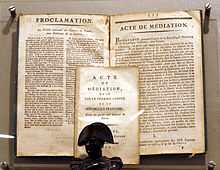
In 1798, the revolutionary French government conquered Switzerland and imposed a new unified constitution. This centralised the government of the country, effectively abolishing the cantons: moreover, Mülhausen joined France and Valtellina valley, the Cisalpine Republic, separating from Switzerland. The new regime, known as the Helvetic Republic, was highly unpopular. It had been imposed by a foreign invading army and destroyed centuries of tradition, making Switzerland nothing more than a French satellite state. The fierce French suppression of the Nidwalden Revolt in September 1798 was an example of the oppressive presence of the French Army and the local population's resistance to the occupation.
When war broke out between France and its rivals, Russian and Austrian forces invaded Switzerland. The Swiss refused to fight alongside the French in the name of the Helvetic Republic. In 1803 Napoleon organised a meeting of the leading Swiss politicians from both sides in Paris. The result was the Act of Mediation which largely restored Swiss autonomy and introduced a Confederation of 19 cantons. Henceforth, much of Swiss politics would concern balancing the cantons' tradition of self-rule with the need for a central government.
In 1815 the Congress of Vienna fully re-established Swiss independence and the European powers agreed to permanently recognise Swiss neutrality. Swiss troops still served foreign governments until 1860 when they fought in the Siege of Gaeta. The treaty also allowed Switzerland to increase its territory, with the admission of the cantons of Valais, Neuchâtel and Geneva. Switzerland's borders have not changed since, except some minor adjustments.
Federal state
Main articles: Restoration and Regeneration (Switzerland) and Switzerland as a federal state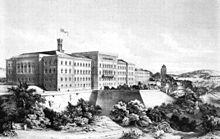
The restoration of the power to the patriciate was only temporary. After a period of unrest with repeated violent clashes such as the Züriputsch of 1839, civil war (the Sonderbundskrieg) broke out in 1847 when some Catholic cantons tried to set up a separate alliance (the Sonderbund). The war lasted for less than a month, causing fewer than 100 casualties, most of which were through friendly fire. However minor the Sonderbundskrieg seems to be when compared with other European riots and wars in the 19th century, it nevertheless had a major impact on both the psychology and the society of the Swiss and of Switzerland.
The war convinced most Swiss of the need for unity and strength towards its European neighbours. Swiss people from all strata of society, whether Catholic or Protestant, from the liberal or conservative current, realised that the cantons would profit more if their economic and religious interests were merged.
Thus, while the rest of Europe saw revolutionary uprisings, the Swiss drew up a constitution which provided for a federal layout, much of it inspired by the American example. This constitution provided for a central authority while leaving the cantons the right to self-government on local issues. Giving credit to those who favoured the power of the cantons (the Sonderbund Kantone), the national assembly was divided between an upper house (the Council of States, two representatives per canton) and a lower house (the National Council, with representatives elected from across the country). Referenda were made mandatory for any amendment of this constitution.

A system of single weights and measures was introduced and in 1850 the Swiss franc became the Swiss single currency. Article 11 of the constitution forbade sending troops to serve abroad, though the Swiss were still obliged to serve Francis II of the Two Sicilies with Swiss Guards present at the Siege of Gaeta in 1860, marking the end of foreign service.
An important clause of the constitution was that it could be re-written completely if this was deemed necessary, thus enabling it to evolve as a whole rather than being modified one amendment at a time.
This need soon proved itself when the rise in population and the Industrial Revolution that followed led to calls to modify the constitution accordingly. An early draft was rejected by the population in 1872 but modifications led to its acceptance in 1874. It introduced the facultative referendum for laws at the federal level. It also established federal responsibility for defense, trade, and legal matters.
In 1891, the constitution was revised with unusually strong elements of direct democracy, which remain unique even today.
Modern history
Main articles: Switzerland during the World Wars and Modern history of Switzerland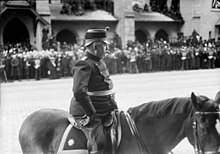
Switzerland was not invaded during either of the world wars. During World War I, Switzerland was home to Vladimir Illych Ulyanov (Vladimir Lenin) and he remained there until 1917. Swiss neutrality was seriously questioned by the Grimm–Hoffmann Affair in 1917, but it was short-lived. In 1920, Switzerland joined the League of Nations, which was based in Geneva, on the condition that it was exempt from any military requirements.
During World War II, detailed invasion plans were drawn up by the Germans, but Switzerland was never attacked. Switzerland was able to remain independent through a combination of military deterrence, concessions to Germany, and good fortune as larger events during the war delayed an invasion. Under General Henri Guisan central command, a general mobilisation of the armed forces was ordered. The Swiss military strategy was changed from one of static defence at the borders to protect the economic heartland, to one of organised long-term attrition and withdrawal to strong, well-stockpiled positions high in the Alps known as the Reduit. Switzerland was an important base for espionage by both sides in the conflict and often mediated communications between the Axis and Allied powers.
Switzerland's trade was blockaded by both the Allies and by the Axis. Economic cooperation and extension of credit to the Third Reich varied according to the perceived likelihood of invasion and the availability of other trading partners. Concessions reached a peak after a crucial rail link through Vichy France was severed in 1942, leaving Switzerland completely surrounded by the Axis. Over the course of the war, Switzerland interned over 300,000 refugees and the International Red Cross, based in Geneva, played an important part during the conflict. Strict immigration and asylum policies as well as the financial relationships with Nazi Germany raised controversy, but not until the end of the 20th century.
During the war, the Swiss Air Force engaged aircraft of both sides, shooting down 11 intruding Luftwaffe planes in May and June 1940, then forcing down other intruders after a change of policy following threats from Germany. Over 100 Allied bombers and their crews were interned during the war. During 1944–45, Allied bombers mistakenly bombed a few places in Switzerland, among which were the cities of Schaffhausen, Basel and Zürich.
After the war, the Swiss government exported credits through the charitable fund known as the Schweizerspende and also donated to the Marshall Plan to help Europe's recovery, efforts that ultimately benefited the Swiss economy.
During the Cold War, Swiss authorities considered the construction of a Swiss nuclear bomb. Leading nuclear physicists at the Federal Institute of Technology Zurich such as Paul Scherrer made this a realistic possibility. However, financial problems with the defense budget prevented the substantial funds from being allocated, and the Nuclear Non-Proliferation Treaty of 1968 was seen as a valid alternative. All remaining plans for building nuclear weapons were dropped by 1988.
Switzerland was the last Western republic to grant women the right to vote with some Swiss cantons approving this in 1959, and later with a federal level in 1971 and, after resistance, in the last canton Appenzell Innerrhoden (one of only two remaining Landsgemeinde) in 1990. After suffrage at the federal level, women quickly rose in political significance, with the first woman on the seven member Federal Council executive being Elisabeth Kopp, who served from 1984–1989, and the first female president being Ruth Dreifuss in 1999.

Switzerland joined the Council of Europe in 1963. In 1979 areas from the canton of Bern attained independence from the Bernese, forming the new canton of Jura. On 18 April 1999 the Swiss population and the cantons voted in favour of a completely revised federal constitution.
In 2002 Switzerland became a full member of the United Nations, leaving the Vatican City as the last widely recognised state without full UN membership. Switzerland is a founding member of the EFTA, but is not a member of the European Economic Area. An application for membership in the European Union was sent in May 1992, but not advanced since the EEA was rejected in December 1992 when Switzerland was the only country to launch a referendum on the EEA. There have since been several referenda on the EU issue; due to a mixed reaction from the population the membership application has been frozen. Nonetheless, Swiss law is gradually being adjusted to conform with that of the EU, and the government has signed a number of bilateral agreements with the European Union. Switzerland, together with Liechtenstein, has been completely surrounded by the EU since Austria's membership in 1995. On 5 June 2005, Swiss voters agreed by a 55% majority to join the Schengen treaty, a result that was regarded by EU commentators as a sign of support by Switzerland, a country that is traditionally perceived as independent and reluctant to enter supranational bodies.
Geography
Main article: Geography of Switzerland
Extending across the north and south side of the Alps in west-central Europe, Switzerland encompasses a great diversity of landscapes and climates on a limited area of 41,285 square kilometres (15,940 sq mi). The population is about 8 million, resulting in an average population density of around 195 people per square kilometre (500/sq mi). The more mountainous southern half of the country is far more sparsely populated than the northern half. In the largest Canton of Graubünden, lying entirely in the Alps, population density falls to 27 /km² (70 /sq mi).
Switzerland lies between latitudes 45° and 48° N, and longitudes 5° and 11° E. It contains three basic topographical areas: the Swiss Alps to the south, the Swiss Plateau or Central Plateau, and the Jura mountains on the west. The Alps are a high mountain range running across the central-south of the country, comprising about 60% of the country's total area. The majority of the Swiss population live in the Swiss Plateau. Among the high valleys of the Swiss Alps many glaciers are found, totalling an area of 1,063 square kilometres (410 sq mi). From these originate the headwaters of several major rivers, such as the Rhine, Inn, Ticino and Rhône, which flow in the four cardinal directions into the whole of Europe. The hydrographic network includes several of the largest bodies of freshwater in Central and Western Europe, among which are included Lake Geneva(also called le Lac Léman in French), Lake Constance (known as Bodensee in German) and Lake Maggiore. Switzerland has more than 1500 lakes, and contains 6% of Europe's stock of fresh water. Lakes and glaciers cover about 6% of the national territory. The largest lake is Lake Geneva, in western Switzerland shared with France. The Rhône is both the main source and outflow of Lake Geneva. Lake Constance is the second largest Swiss lake and, like the Lake Geneva, an intermediate step by the Rhine at the border to Austria and Germany. While the Rhône flows into the Mediterranean Sea at the French Camarque region and the Rhine flows into the North Sea at Rotterdam in the Netherlands, about 1000 km apart, both springs are only about 22 km apart from each other in the Swiss Alps.

 Contrasted landscapes between the regions of the Matterhorn and Lake Lucerne
Contrasted landscapes between the regions of the Matterhorn and Lake Lucerne
48 of Switzerland's mountains are 4,000 metres (13,000 ft) above sea in altitude or higher. At 4,634 m (15,203 ft), Monte Rosa is the highest, although the Matterhorn (4,478 m or 14,692 ft) is often regarded as the most famous. Both are located within the Pennine Alps in the canton of Valais. The section of the Bernese Alps above the deep glacial Lauterbrunnen valley, containing 72 waterfalls, is well known for the Jungfrau (4,158 m or 13,642 ft) Eiger and Mönch, and the many picturesque valleys in the region. In the southeast the long Engadin Valley, encompassing the St. Moritz area in canton of Graubünden, is also well known; the highest peak in the neighbouring Bernina Alps is Piz Bernina (4,049 m or 13,284 ft).
The more populous northern part of the country, comprising about 30% of the country's total area, is called the Swiss Plateau. It has greater open and hilly landscapes, partly forested, partly open pastures, usually with grazing herds, or vegetables and fruit fields, but it is still hilly. There are large lakes found here and the biggest Swiss cities are in this area of the country.
Climate
The Swiss climate is generally temperate, but can vary greatly between the localities, from glacial conditions on the mountaintops to the often pleasant near Mediterranean climate at Switzerland's southern tip. There are some valley areas in the southern part of Switzerland where some cold-hardy palm trees are found. Summers tend to be warm and humid at times with periodic rainfall so they are ideal for pastures and grazing. The less humid winters in the mountains may see long intervals of stable conditions for weeks, while the lower lands tend to suffer from inversion, during these periods, thus seeing no sun for weeks.
A weather phenomenon known as the föhn (with an identical effect to the chinook wind) can occur at all times of the year and is characterised by an unexpectedly warm wind, bringing air of very low relative humidity to the north of the Alps during rainfall periods on the southern face of the Alps. This works both ways across the alps but is more efficient if blowing from the south due to the steeper step for oncoming wind from the south. Valleys running south to north trigger the best effect. The driest conditions persist in all inner alpine valleys that receive less rain because arriving clouds lose a lot of their content while crossing the mountains before reaching these areas. Large alpine areas such as Graubünden remain drier than pre-alpine areas and as in the main valley of the Valais wine grapes are grown there.
The wettest conditions persist in the high Alps and in the Ticino canton which has much sun yet heavy bursts of rain from time to time. Precipitation tends to be spread moderately throughout the year with a peak in summer. Autumn is the driest season, winter receives less precipitation than summer, yet the weather patterns in Switzerland are not in a stable climate system and can be variable from year to year with no strict and predictable periods.
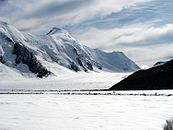


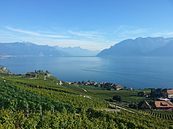 Contrasted climates between the most glaciated area in western Eurasia (Aletsch Glacier), the cold temperate Jura (Vallée de Joux), the southern canton of Ticino (Lake Lugano), and the western canton of Vaud and its vine terraces (Lake Geneva)
Contrasted climates between the most glaciated area in western Eurasia (Aletsch Glacier), the cold temperate Jura (Vallée de Joux), the southern canton of Ticino (Lake Lugano), and the western canton of Vaud and its vine terraces (Lake Geneva)
Environment
Switzerland's ecosystems can be particularly fragile, because the many delicate valleys separated by high mountains often form unique ecologies. The mountainous regions themselves are also vulnerable, with a rich range of plants not found at other altitudes, and experience some pressure from visitors and grazing. The climatic, geological and topographical conditions of the alpine region make for a very fragile ecosystem that is particularly sensitive to climate change. Nevertheless, according to the 2014 Environmental Performance Index, Switzerland ranks first among 132 nations in safeguarding the environment, due to its high scores on environmental public health, its heavy reliance on renewable sources of energy (hydropower and geothermal energy), and its control of greenhouse gas emissions.
Politics
Main article: Politics of Switzerland
The Federal Constitution adopted in 1848 is the legal foundation of the modern federal state. It is among the oldest constitutions in the world. A new Constitution was adopted in 1999, but did not introduce notable changes to the federal structure. It outlines basic and political rights of individuals and citizen participation in public affairs, divides the powers between the Confederation and the cantons and defines federal jurisdiction and authority. There are three main governing bodies on the federal level: the bicameral parliament (legislative), the Federal Council (executive) and the Federal Court (judicial).

The Swiss Parliament consists of two houses: the Council of States which has 46 representatives (two from each canton and one from each half-canton) who are elected under a system determined by each canton, and the National Council, which consists of 200 members who are elected under a system of proportional representation, depending on the population of each canton. Members of both houses serve for 4 years. When both houses are in joint session, they are known collectively as the Federal Assembly. Through referendums, citizens may challenge any law passed by parliament and through initiatives, introduce amendments to the federal constitution, thus making Switzerland a direct democracy.
The Federal Council constitutes the federal government, directs the federal administration and serves as collective Head of State. It is a collegial body of seven members, elected for a four-year mandate by the Federal Assembly which also exercises oversight over the Council. The President of the Confederation is elected by the Assembly from among the seven members, traditionally in rotation and for a one-year term; the President chairs the government and assumes representative functions. However, the president is a primus inter pares with no additional powers, and remains the head of a department within the administration.
The Swiss government has been a coalition of the four major political parties since 1959, each party having a number of seats that roughly reflects its share of electorate and representation in the federal parliament. The classic distribution of 2 CVP/PDC, 2 SPS/PSS, 2 FDP/PRD and 1 SVP/UDC as it stood from 1959 to 2003 was known as the "magic formula". Following the 2011 Federal Council elections, the seven seats in the Federal Council were distributed as follows:
- 1 seat for the Christian Democratic People's Party (CVP/PDC),
- 1 seat for the Conservative Democratic Party (BDP/PBD),
- 2 seats for the Free Democratic Party (FDP/PRD),
- 2 seats for the Social Democratic Party (SPS/PSS),
- 1 seat for the Swiss People's Party (SVP/UDC).
The function of the Federal Supreme Court is to hear appeals against rulings of cantonal or federal courts. The judges are elected by the Federal Assembly for six-year terms.
Direct democracy
Main article: Voting in Switzerland
Swiss citizens are subject to three legal jurisdictions: the commune, canton and federal levels. The 1848 federal constitution defines a system of direct democracy (sometimes called half-direct or representative direct democracy because it is aided by the more commonplace institutions of a representative democracy). The instruments of this system at the federal level, known as civic rights (Volksrechte, droits civiques), include the right to submit a constitutional initiative and a referendum, both of which may overturn parliamentary decisions.
By calling a federal referendum, a group of citizens may challenge a law passed by Parliament, if they gather 50,000 signatures against the law within 100 days. If so, a national vote is scheduled where voters decide by a simple majority whether to accept or reject the law. Any 8 cantons together can also call a referendum on a federal law.
Similarly, the federal constitutional initiative allows citizens to put a constitutional amendment to a national vote, if 100,000 voters sign the proposed amendment within 18 months. Parliament can supplement the proposed amendment with a counter-proposal, and then voters must indicate a preference on the ballot in case both proposals are accepted. Constitutional amendments, whether introduced by initiative or in Parliament, must be accepted by a double majority of the national popular vote and the cantonal popular votes.
Administrative divisions
Main article: Cantons of SwitzerlandThe Swiss Confederation consists of 20 cantons and 6 half cantons:
*These cantons are known as half-cantons and are thus represented by only one councillor (instead of two) in the Council of States.
The cantons have a permanent constitutional status and, in comparison with the situation in other countries, a high degree of independence. Under the Federal Constitution, all 26 cantons are equal in status. Each canton has its own constitution, and its own parliament, government and courts. However, there are considerable differences between the individual cantons, most particularly in terms of population and geographical area. Their populations vary between 15,000 (Appenzell Innerrhoden) and 1,253,500 (Zürich), and their area between 37 km (14 sq mi) (Basel-Stadt) and 7,105 km (2,743 sq mi) (Graubünden). The Cantons comprise a total of 2,485 municipalities. Within Switzerland there are two enclaves: Büsingen belongs to Germany, Campione d'Italia belongs to Italy.
Foreign relations and international institutions
Main article: Foreign relations of SwitzerlandTraditionally, Switzerland avoids alliances that might entail military, political, or direct economic action and has been neutral since the end of its expansion in 1515. Its policy of neutrality was internationally recognised at the Congress of Vienna in 1815. Only in 2002 did Switzerland become a full member of the United Nations and it was the first state to join it by referendum. Switzerland maintains diplomatic relations with almost all countries and historically has served as an intermediary between other states. Switzerland is not a member of the European Union; the Swiss people have consistently rejected membership since the early 1990s.
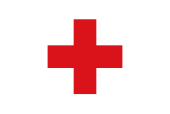
A large number of international institutions have their seats in Switzerland, in part because of its policy of neutrality. Geneva is the birthplace of the Red Cross and Red Crescent Movement and the Geneva Conventions and, since 2006, hosts the United Nations Human Rights Council. Even though Switzerland is one of the most recent countries to have joined the United Nations, the Palace of Nations in Geneva is the second biggest centre for the United Nations after New York, and Switzerland was a founding member and home to the League of Nations.
Apart from the United Nations headquarters, the Swiss Confederation is host to many UN agencies, like the World Health Organization (WHO), the International Labour Organization (ILO), the International Telecommunication Union (ITU), the United Nations High Commissioner for Refugees (UNHCR) and about 200 other international organisations, including the World Trade Organization and the World Intellectual Property Organization. The annual meetings of the World Economic Forum in Davos bring together top international business and political leaders from Switzerland and foreign countries to discuss important issues facing the world, including health and the environment.
Furthermore, many sport federations and organisations are located throughout the country, such as the International Basketball Federation in Geneva, the Union of European Football Associations (UEFA) in Nyon, the International Federation of Association Football (FIFA) and the International Ice Hockey Federation both in Zürich, the International Cycling Union in Aigle, and the International Olympic Committee in Lausanne.
Military
Main article: Military of Switzerland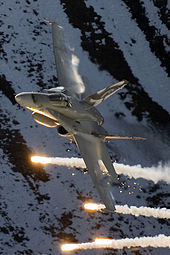
The Swiss Armed Forces, including the Land Forces and the Air Force, are composed mostly of conscripts, male citizens aged from 20 to 34 (in special cases up to 50) years. Being a landlocked country, Switzerland has no navy; however, on lakes bordering neighbouring countries, armed military patrol boats are used. Swiss citizens are prohibited from serving in foreign armies, except for the Swiss Guards of the Vatican, or if they are dual citizens of a foreign country and reside there.
The structure of the Swiss militia system stipulates that the soldiers keep their Army issued equipment, including all personal weapons, at home. Some organizations and political parties find this practice controversial but mainstream Swiss opinion is in favour of the system. Compulsory military service concerns all male Swiss citizens; women can serve voluntarily. Men usually receive military conscription orders for training at the age of 18. About two thirds of the young Swiss are found suited for service; for those found unsuited, various forms of alternative service exist. Annually, approximately 20,000 persons are trained in recruit centres for a duration from 18 to 21 weeks. The reform "Army XXI" was adopted by popular vote in 2003, it replaced the previous model "Army 95", reducing the effectives from 400,000 to about 200,000. Of those, 120,000 are active in periodic Army training and 80,000 are non-training reserves.
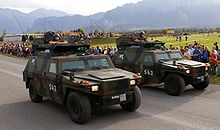
Overall, three general mobilisations have been declared to ensure the integrity and neutrality of Switzerland. The first one was held on the occasion of the Franco-Prussian War of 1870–71. The second one was decided in response to the outbreak of the First World War in August 1914. The third mobilisation of the army took place in September 1939 in response to the German attack on Poland; Henri Guisan was elected as the General-in-Chief.
Because of its neutrality policy, the Swiss army does not currently take part in armed conflicts in other countries, but is part of some peacekeeping missions around the world. Since 2000 the armed force department has also maintained the Onyx intelligence gathering system to monitor satellite communications.
Following the end of the Cold War there have been a number of attempts to curb military activity or even abolish the armed forces altogether. A notable referendum on the subject, launched by an anti-militarist group, was held on 26 November 1989. It was defeated with about two thirds of the voters against the proposal. A similar referendum, called for before, but held shortly after the 11 September attacks in the US, was defeated by over 78% of voters.
Economy and labour law
Main article: Economy of Switzerland See also: Banking in Switzerland, Taxation in Switzerland, and Federal budget of Switzerland
Switzerland has a stable, prosperous and high-tech economy and enjoys great wealth, being ranked as the wealthiest country in the world in per capita in multiple rankings. In 2011 it was ranked as the wealthiest country in the world in per capita terms (with "wealth" being defined to include both financial and non-financial assets), while the 2013 Credit Suisse Global Wealth Report showed that Switzerland was the country with the highest average wealth per adult in 2013. It has the world's nineteenth largest economy by nominal GDP and the thirty-sixth largest by purchasing power parity. It is the twentieth largest exporter, despite its small size. Switzerland has the highest European rating in the Index of Economic Freedom 2010, while also providing large coverage through public services. The nominal per capita GDP is higher than those of the larger Western and Central European economies and Japan. If adjusted for purchasing power parity, Switzerland ranks 8th in the world in terms of GDP per capita, according to the World Bank and IMF (ranked 15th according to the CIA Worldfactbook).
The World Economic Forum's Global Competitiveness Report currently ranks Switzerland's economy as the most competitive in the world, while ranked by the European Union as Europe's most innovative country. For much of the 20th century, Switzerland was the wealthiest country in Europe by a considerable margin (by GDP – per capita). In 2007 the gross median household income in Switzerland was an estimated 137,094 USD at Purchasing power parity while the median income was 95,824 USD. Switzerland also has one of the world's largest account balances as a percentage of GDP.
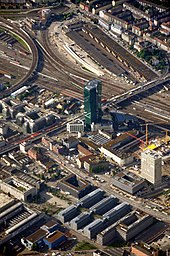
Switzerland is home to several large multinational corporations. The largest Swiss companies by revenue are Glencore, Gunvor, Nestlé, Novartis, Hoffmann-La Roche, ABB, Mercuria Energy Group and Adecco. Also, notable are UBS AG, Zurich Financial Services, Credit Suisse, Barry Callebaut, Swiss Re, Tetra Pak, The Swatch Group and Swiss International Airlines. Switzerland is ranked as having one of the most powerful economies in the world.
Switzerland's most important economic sector is manufacturing. Manufacturing consists largely of the production of specialist chemicals, health and pharmaceutical goods, scientific and precision measuring instruments and musical instruments. The largest exported goods are chemicals (34% of exported goods), machines/electronics (20.9%), and precision instruments/watches (16.9%). Exported services amount to a third of exports. The service sector – especially banking and insurance, tourism, and international organisations – is another important industry for Switzerland.
Around 3.8 million people work in Switzerland; about 25% of employees belonged to a trade union in 2004. Switzerland has a more flexible job market than neighbouring countries and the unemployment rate is very low. The unemployment rate increased from a low of 1.7% in June 2000 to a peak of 4.4% in December 2009. Population growth from net immigration is quite high, at 0.52% of population in 2004. The foreign citizen population was 21.8% in 2004, about the same as in Australia. GDP per hour worked is the world's 16th highest, at 49.46 international dollars in 2012.
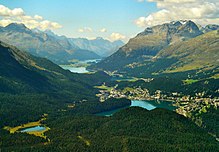
Switzerland has an overwhelmingly private sector economy and low tax rates by Western World standards; overall taxation is one of the smallest of developed countries. Switzerland is a relatively easy place to do business, currently ranking 28th of 178 countries in the Ease of Doing Business Index. The slow growth Switzerland experienced in the 1990s and the early 2000s has brought greater support for economic reforms and harmonization with the European Union. According to Credit Suisse, only about 37% of residents own their own homes, one of the lowest rates of home ownership in Europe. Housing and food price levels were 171% and 145% of the EU-25 index in 2007, compared to 113% and 104% in Germany.
The Swiss Federal budget had a size of 62.8 billion Swiss francs in 2010, which is an equivalent 11.35% of the country's GDP in that year; however, the regional (canton) budgets and the budgets of the municipalities are not counted as part of the federal budget and the total rate of government spending is closer to 33.8% of GDP. The main sources of income for the federal government are the value-added tax (33%) and the direct federal tax (29%) and the main expenditure is located in the areas of social welfare and finance & tax. The expenditures of the Swiss Confederation have been growing from 7% of GDP in 1960 to 9.7% in 1990 and to 10.7% in 2010. While the sectors social welfare and finance & tax have been growing from 35% in 1990 to 48.2% in 2010, a significant reduction of expenditures has been occurring in the sectors of agriculture and national defense; from 26.5% in to 12.4% (estimation for the year 2015).
Agricultural protectionism—a rare exception to Switzerland's free trade policies—has contributed to high food prices. Product market liberalisation is lagging behind many EU countries according to the OECD. Nevertheless, domestic purchasing power is one of the best in the world. Apart from agriculture, economic and trade barriers between the European Union and Switzerland are minimal and Switzerland has free trade agreements worldwide. Switzerland is a member of the European Free Trade Association (EFTA).
Switzerland has the world's nineteenth largest economy by nominal GDP and the thirty-sixth largest by purchasing power parity. Switzerland is the fifteenth largest exporter and seventeenth largest importer of goods.
Education and science
Main articles: Education in Switzerland and Science and technology in Switzerland
Leonhard Euler (mathematics)
Louis Agassiz (glaciology)
Auguste Piccard (aeronautics)
Albert Einstein (physics)
Education in Switzerland is very diverse because the constitution of Switzerland delegates the authority for the school system to the cantons. There are both public and private schools, including many private international schools. The minimum age for primary school is about six years in all cantons, but most cantons provide a free "children's school" starting at four or five years old. Primary school continues until grade four, five or six, depending on the school. Traditionally, the first foreign language in school was always one of the other national languages, although recently (2000) English was introduced first in a few cantons.
At the end of primary school (or at the beginning of secondary school), pupils are separated according to their capacities in several (often three) sections. The fastest learners are taught advanced classes to be prepared for further studies and the matura, while students who assimilate a little more slowly receive an education more adapted to their needs.

There are 12 universities in Switzerland, ten of which are maintained at cantonal level and usually offer a range of non-technical subjects. The first university in Switzerland was founded in 1460 in Basel (with a faculty of medicine) and has a tradition of chemical and medical research in Switzerland. The biggest university in Switzerland is the University of Zurich with nearly 25,000 students. The two institutes sponsored by the federal government are the ETHZ in Zürich (founded 1855) and the EPFL in Lausanne (founded 1969 as such, formerly an institute associated with the University of Lausanne) which both have an excellent international reputation.
In addition, there are various Universities of Applied Sciences. In business and management studies, University of St. Gallen, (HSG) and International Institute for Management Development (IMD) are the leaders within the country and highly regarded internationally. Switzerland has the second highest rate (almost 18% in 2003) of foreign students in tertiary education, after Australia (slightly over 18%).
As might befit a country that plays home to innumerable international organizations, the Graduate Institute of International and Development Studies, located in Geneva, is not only continental Europe's oldest graduate school of international and development studies, but also widely believed to be one of its most prestigious.
Many Nobel prizes have been awarded to Swiss scientists, for example to the world-famous physicist Albert Einstein in the field of physics who developed his Special relativity while working in Bern. More recently Vladimir Prelog, Heinrich Rohrer, Richard Ernst, Edmond Fischer, Rolf Zinkernagel and Kurt Wüthrich received Nobel prizes in the sciences. In total, 113 Nobel Prize winners in all fields stand in relation to Switzerland and the Nobel Peace Prize has been awarded nine times to organisations residing in Switzerland.
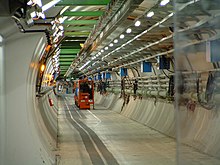
Geneva and the nearby French department of Ain co-host the world's largest laboratory, CERN, dedicated to particle physics research. Another important research center is the Paul Scherrer Institute. Notable inventions include lysergic acid diethylamide (LSD), the scanning tunneling microscope (Nobel prize) and Velcro. Some technologies enabled the exploration of new worlds such as the pressurized balloon of Auguste Piccard and the Bathyscaphe which permitted Jacques Piccard to reach the deepest point of the world's oceans.
Switzerland Space Agency, the Swiss Space Office, has been involved in various space technologies and programs. In addition it was one of the 10 founders of the European Space Agency in 1975 and is the seventh largest contributor to the ESA budget. In the private sector, several companies are implicated in the space industry such as Oerlikon Space or Maxon Motors who provide spacecraft structures.
Switzerland and the European Union
Main article: Switzerland–European Union relationsSwitzerland voted against membership in the European Economic Area in a referendum in December 1992 and has since maintained and developed its relationships with the European Union (EU) and European countries through bilateral agreements. In March 2001, the Swiss people refused in a popular vote to start accession negotiations with the EU. In recent years, the Swiss have brought their economic practices largely into conformity with those of the EU in many ways, in an effort to enhance their international competitiveness. The economy grew at 3% in 2010, 1.9% in 2011, and 1% in 2012. Full EU membership is a long-term objective of some in the Swiss government, but there is considerable popular sentiment against this supported by the conservative SVP party. The western French-speaking areas and the urban regions of the rest of the country tend to be more pro-EU, however with far from any significant share of the population.
The government has established an Integration Office under the Department of Foreign Affairs and the Department of Economic Affairs. To minimise the negative consequences of Switzerland's isolation from the rest of Europe, Bern and Brussels signed seven bilateral agreements to further liberalise trade ties. These agreements were signed in 1999 and took effect in 2001. This first series of bilateral agreements included the free movement of persons. A second series covering nine areas was signed in 2004 and has since been ratified, which includes the Schengen Treaty and the Dublin Convention besides others. They continue to discuss further areas for cooperation.
In 2006, Switzerland approved 1000 million francs of supportive investment in the poorer Southern and Central European countries in support of cooperation and positive ties to the EU as a whole. A further referendum will be needed to approve 300 million francs to support Romania and Bulgaria and their recent admission. The Swiss have also been under EU and sometimes international pressure to reduce banking secrecy and to raise tax rates to parity with the EU. Preparatory discussions are being opened in four new areas: opening up the electricity market, participation in the European GNSS project Galileo, cooperating with the European centre for disease prevention and recognising certificates of origin for food products.
On 27 November 2008, the interior and justice ministers of European Union in Brussels announced Switzerland's accession to the Schengen passport-free zone from 12 December 2008. The land border checkpoints will remain in place only for goods movements, but should not run controls on people, though people entering the country had their passports checked until 29 March 2009 if they originated from a Schengen nation.
On 9 February 2014, Swiss voters narrowly approved by 50.3% a ballot initiative launched by the national conservative Swiss People's Party (SVP/UDC) to restrict immigration, and thus reintroducing a quota system on the influx of foreigners. This initiative was mostly backed by rural (57.6% approvals), suburban (51.2% approvals), and isolated cities (51.3% approvals) of Switzerland as well as by a strong majority (69.2% approval) in the canton of Ticino, while metropolitan centers (58.5% rejection) and the French-speaking part (58.5% rejection) of Switzerland rather rejected it. Some news commentators claim that this proposal de facto contradicts the bilateral agreements on the free movement of persons from these respective countries.
Energy, infrastructure and environment
See also: Energy in Switzerland, Transport in Switzerland, Waste management in Switzerland, and Environment of Switzerland
Electricity generated in Switzerland is 56% from hydroelectricity and 39% from nuclear power, resulting in a nearly CO2-free electricity-generating network. On 18 May 2003, two anti-nuclear initiatives were turned down: Moratorium Plus, aimed at forbidding the building of new nuclear power plants (41.6% supported and 58.4% opposed), and Electricity Without Nuclear (33.7% supported and 66.3% opposed).
The former ten-year moratorium on the construction of new nuclear power plants was the result of a citizens' initiative voted on in 1990 which had passed with 54.5% Yes vs. 45.5% No votes. Plans for a new nuclear plant in the Canton of Bern have been put on hold after the accident at the Fukushima Daiichi power plant in 2011. The Swiss Federal Office of Energy (SFOE) is the office responsible for all questions relating to energy supply and energy use within the Federal Department of Environment, Transport, Energy and Communications (DETEC). The agency is supporting the 2000-watt society initiative to cut the nation's energy use by more than half by the year 2050.
On 25 May 2011 the Swiss government announced that it plans to end its use of nuclear energy in the next 2 or 3 decades. "The government has voted for a phaseout because we want to ensure a secure and autonomous supply of energy", Energy Minister Doris Leuthard said that day at a press conference in Bern. "Fukushima showed that the risk of nuclear power is too high, which in turn has also increased the costs of this energy form." The first reactor would reportedly be taken offline in 2019 and the last one in 2034. Parliament will discuss the plan in June 2011, and there could be a referendum as well.

The most dense rail network in Europe of 5,063 km (3,146 mi) carries over 350 million passengers annually. In 2007, each Swiss citizen travelled on average 2,258 km (1,403 mi) by rail, which makes them the keenest rail users. The network is administered mainly by the Federal Railways, except in Graubünden, where the 366 km (227 mi) narrow gauge railway is operated by the Rhaetian Railways and includes some World Heritage lines. The building of new railway base tunnels through the Alps is under way to reduce the time of travel between north and south through the AlpTransit project.
Swiss private-public managed road network is funded by road tolls and vehicle taxes. The Swiss autobahn/autoroute system requires the purchase of a vignette (toll sticker)—which costs 40 Swiss francs—for one calendar year in order to use its roadways, for both passenger cars and trucks. The Swiss autobahn/autoroute network has a total length of 1,638 km (1,018 mi) (as of 2000) and has, by an area of 41,290 km (15,940 sq mi), also one of the highest motorway densities in the world. Zürich Airport is Switzerland's largest international flight gateway, which handled 22.8 million passengers in 2012. The other international airports are Geneva Airport (13.9 million passengers in 2012), EuroAirport Basel-Mulhouse-Freiburg which is located in France, Bern Airport, Lugano Airport, St. Gallen-Altenrhein Airport and Sion Airport. Swiss International Airlines is the flag carrier of Switzerland. Its main hub is Zürich.
Switzerland has one of the best environmental records among nations in the developed world; it was one of the countries to sign the Kyoto Protocol in 1998 and ratified it in 2003. With Mexico and the Republic of Korea it forms the Environmental Integrity Group (EIG). The country is heavily active in recycling and anti-littering regulations and is one of the top recyclers in the world, with 66% to 96% of recyclable materials being recycled, depending on the area of the country. The 2014 Global Green Economy Index ranked Switzerland among the top 10 green economies in the world.
In many places in Switzerland, household rubbish disposal is charged for. Rubbish (except dangerous items, batteries etc.) is only collected if it is in bags which either have a payment sticker attached, or in official bags with the surcharge paid at the time of purchase. This gives a financial incentive to recycle as much as possible, since recycling is free. Illegal disposal of garbage is not tolerated but usually the enforcement of such laws is limited to violations that involve the unlawful disposal of larger volumes at traffic intersections and public areas. Fines for not paying the disposal fee range from CHF 200–500.
Switzerland also has internationally the most efficient system to recycle old newspapers and cardboard materials. Publicly organised collection by volunteers and economical railway transport logistics started as early as 1865 under the leadership of the notable industrialist Hans Caspar Escher (Escher Wyss AG) when the first modern Swiss paper manufacturing plant was built in Biberist.
Demographics
Main articles: Demographics of Switzerland and Swiss people Further information: List of Swiss people

In 2012, Switzerland's population slightly exceeded eight million. The Swiss population quadrupled between 1800 and 1990.
In 2012, resident foreigners made up 23.3% of the population. Most of these (64%) were from European Union or EFTA countries. Italians were the largest single group of foreigners with 15.6% of total foreign population. They were closely followed by Germans (15.2%), immigrants from Portugal (12.7%), France (5.6%), Serbia (5.3%), Turkey (3.8%), Spain (3.7%), and Austria (2%). Immigrants from Sri Lanka, most of them former Tamil refugees, were the largest group among people of Asian origin (6.3%). Additionally, the figures from 2012 show that 34.7% of the permanent resident population aged 15 or over in Switzerland, i.e. 2,335,000 persons, had an immigrant background. A third of this population (853,000) held Swiss citizenship. Four fifths of persons with an immigration background were themselves immigrants (first generation foreigners and native-born and naturalised Swiss citizens), whereas one fifth were born in Switzerland (second generation foreigners and native-born and naturalised Swiss citizens). In the 2000s, domestic and international institutions expressed concern about what they perceived as an increase in xenophobia, particularly in some political campaigns. In reply to one critical report the Federal Council noted that "racism unfortunately is present in Switzerland", but stated that the high proportion of foreign citizens in the country, as well as the generally unproblematic integration of foreigners", underlined Switzerland's openness.
Languages
Main article: Linguistic geography of Switzerland
Switzerland has four official languages: principally German (65.3% total population share, with foreign residents; 73.2% of residents with Swiss citizenship, in 2011); French (22.4%; 23.1%) in the west; Italian (8.4%; 6.1%) in the south. Romansh (0.6%; 0.7%), a Romance language spoken locally in the southeastern trilingual canton of Graubünden, is designated by the Federal Constitution as a national language along with German, French and Italian (Article 4 of the Constitution), and as official language if the authorities communicate with persons of Romansh language (Article 70), but federal laws and other official acts do not need to be decreed in this language.
In 2011, the languages most spoken at home among permanent residents aged 15 and older were: Swiss German (4,027,917, or 61.1%); French (1,523,094, 23.1%); Standard German (637,439, 9.7%); Italian (545,274, 8.2%); Ticinese and Grisons (107,973, 1.6%); Romansh (37,490, 0.57%); and English (278,407, 4.2%). Speakers of other languages at home numbered 1,382,508, or 16.5% of the population.
The federal government is obliged to communicate in the official languages, and in the federal parliament simultaneous translation is provided from and into German, French and Italian.
Aside from the official forms of their respective languages, the four linguistic regions of Switzerland also have their local dialectal forms. The role played by dialects in each linguistic region varies dramatically: in the German-speaking regions, Swiss German dialects became ever more prevalent since the second half of the 20th century, especially in the media, such as radio and television, and are used as an everyday language, while (the Swiss variety of) Standard German is used for almost all written situations (c.f. diglossic usage of a language). Conversely, in the French-speaking regions the local dialects have almost disappeared (only 6.3% of the population of Valais, 3.9% of Fribourg, and 3.1% of Jura still spoke dialects at the end of the 20th century), while in the Italian-speaking regions dialects are mostly limited to family settings and casual conversation.
The official languages (German, French and Italian) have terms, not used outside of Switzerland, known as Helvetisms. German Helvetisms are, roughly spoken, a large group of words typical of Swiss Standard German, which do not appear in either of Standard German, nor Standard German dialects. E.g. terms from Switzerland's surrounding language cultures (German Billette from French), from similar term in another language (Italian azione used not only as act but also as discount from German Aktion). The French spoken in Switzerland has similar terms, which are equally known as Helvetisms. The most frequent characteristics of Helvetisms are in vocabulary, phrases, and pronunciation, but certain Helvetisms denote themselves as special in syntax and orthography likewise. Duden, one of the prescriptive sources for Standard German, is aware of about 3000 Helvetisms. Current French dictionaries, such as the Petit Larousse, include several hundred Helvetisms.
Learning one of the other national languages at school is compulsory for all Swiss students, so many Swiss are supposed to be at least bilingual, especially those belonging to minorities.
Health
Main article: Healthcare in SwitzerlandSwiss citizens are universally required to buy health insurance from private insurance companies, which in turn are required to accept every applicant. While the cost of the system is among the highest, the system compares well with other European countries in terms of health outcomes, so patients who are citizens have been reported as generally highly satisfied with it. In 2012, life expectancy at birth was 80.4 years for men and 84.7 years for women. These are the world's highest life expectancy. However, spending on health is particularly high, with 11.4% of GDP (2010), however in par with Germany and France (11.6%) and other European countries, but far less than in USA (17.6%). From 1990, a steady increase is observed, reflecting the high prices of the services provided. With aging populations and new healthcare technologies, health spending will likely continue to rise.
Urbanization
Main article: Cities of Switzerland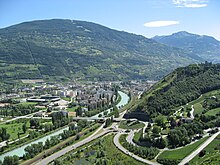
Between two thirds and three quarters of the population live in urban areas. Switzerland has gone from a largely rural country to an urban one in just 70 years. Since 1935 urban development has claimed as much of the Swiss landscape as it did during the previous 2,000 years. This urban sprawl does not only affect the plateau but also the Jura and the Alpine foothills and there are growing concerns about land use. However, from the beginning of the 21st century, the population growth in urban areas is higher than in the countryside.
Switzerland has a dense network of cities, where large, medium and small cities are complementary. The plateau is very densely populated with about 450 people per km and the landscape continually shows signs of man's presence. The weight of the largest metropolitan areas, which are Zürich, Geneva–Lausanne, Basel and Bern tend to increase. In international comparison the importance of these urban areas is stronger than their number of inhabitants suggests. In addition the two main centers of Zürich and Geneva are recognized for their particularly great quality of life.
Religion
Main article: Religion in Switzerland
Switzerland has no official state religion, though most of the cantons (except Geneva and Neuchâtel) recognize official churches, which are either the Catholic Church or the (Protestant) Swiss Reformed Church. These churches, along with some other congregations, are financed by official taxation of adherents.
Christianity is the predominant religion of Switzerland (about 71% of resident population), divided between the Catholic Church (38.21% of the population), the Swiss Reformed Church (26.93%), further Protestant churches (2.89%) and other Christian denominations (2.79%). There has been a recent rise in Evangelicalism.
As of the 2000 census other Christian minority communities include Neo-Pietism (0.44%), Pentecostalism (0.28%, mostly incorporated in the Schweizer Pfingstmission), Methodism (0.13%), the New Apostolic Church (0.45%), Jehovah's Witnesses (0.28%), other Protestant denominations (0.20%), the Old Catholic Church (0.18%), other Christian denominations (0.20%).

The country was historically about evenly balanced between Catholic and Protestant, with a complex patchwork of majorities over most of the country. Geneva converted to Protestantism in 1536, just before John Calvin arrived there. One canton, Appenzell, was officially divided into Catholic and Protestant sections in 1597. The larger cities and their cantons (Bern, Geneva, Lausanne, Zürich and Basel) used to be predominantly Protestant. Central Switzerland, the Valais, the Ticino, Appenzell Innerrhodes, the Jura, and Fribourg are traditionally Catholic. The Swiss Constitution of 1848, under the recent impression of the clashes of Catholic vs. Protestant cantons that culminated in the Sonderbundskrieg, consciously defines a consociational state, allowing the peaceful co-existence of Catholics and Protestants. A 1980 initiative calling for the complete separation of church and state was rejected by 78.9% of the voters.
Culture
Main article: Culture of Switzerland See also: Music of Switzerland, Swiss folklore, and Alpine culture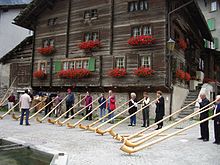
Three of Europe's major languages are official in Switzerland. Swiss culture is characterised by diversity, which is reflected in a wide range of traditional customs. A region may be in some ways strongly culturally connected to the neighbouring country that shares its language, the country itself being rooted in western European culture. The linguistically isolated Romansh culture in Graubünden in eastern Switzerland constitutes an exception, it survives only in the upper valleys of the Rhine and the Inn and strives to maintain its rare linguistic tradition.
Switzerland is home to many notable contributors to literature, art, architecture, music and sciences. In addition the country attracted a number of creative persons during time of unrest or war in Europe. Some 1000 museums are distributed through the country; the number has more than tripled since 1950. Among the most important cultural performances held annually are the Lucerne Festival, the Montreux Jazz Festival and the Locarno International Film Festival.
Alpine symbolism has played an essential role in shaping the history of the country and the Swiss national identity. Nowadays some concentrated mountain areas have a strong highly energetic ski resort culture in winter, and a hiking (ger: das Wandern) or Mountain biking culture in summer. Other areas throughout the year have a recreational culture that caters to tourism, yet the quieter seasons are spring and autumn when there are fewer visitors. A traditional farmer and herder culture also predominates in many areas and small farms are omnipresent outside the cities. Folk art is kept alive in organisations all over the country. In Switzerland it is mostly expressed in music, dance, poetry, wood carving and embroidery. The alphorn, a trumpet-like musical instrument made of wood, has become alongside yodeling and the accordion an epitome of traditional Swiss music.
Literature
Main article: Literature of Switzerland
As the Confederation, from its foundation in 1291, was almost exclusively composed of German-speaking regions, the earliest forms of literature are in German. In the 18th century, French became the fashionable language in Bern and elsewhere, while the influence of the French-speaking allies and subject lands was more marked than before.
Among the classics of Swiss German literature are Jeremias Gotthelf (1797–1854) and Gottfried Keller (1819–1890). The undisputed giants of 20th century Swiss literature are Max Frisch (1911–91) and Friedrich Dürrenmatt (1921–90), whose repertoire includes Die Physiker (The Physicists) and Das Versprechen (The Pledge), released in 2001 as a Hollywood film.
Prominent French-speaking writers were Jean-Jacques Rousseau (1712–1778) and Germaine de Staël (1766–1817). More recent authors include Charles Ferdinand Ramuz (1878–1947), whose novels describe the lives of peasants and mountain dwellers, set in a harsh environment and Blaise Cendrars (born Frédéric Sauser, 1887–1961). Also Italian and Romansh-speaking authors contributed but in more modest way given their small number.
Probably the most famous Swiss literary creation, Heidi, the story of an orphan girl who lives with her grandfather in the Alps, is one of the most popular children's books ever and has come to be a symbol of Switzerland. Her creator, Johanna Spyri (1827–1901), wrote a number of other books on similar themes.
Media
Main article: Media of SwitzerlandThe freedom of the press and the right to free expression is guaranteed in the federal constitution of Switzerland. The Swiss News Agency (SNA) broadcasts information around-the-clock in three of the four national languages—on politics, economics, society and culture. The SNA supplies almost all Swiss media and a couple dozen foreign media services with its news.
Switzerland has historically boasted the greatest number of newspaper titles published in proportion to its population and size. The most influential newspapers are the German-language Tages-Anzeiger and Neue Zürcher Zeitung NZZ, and the French-language Le Temps, but almost every city has at least one local newspaper. The cultural diversity accounts for a large number of newspapers.
The government exerts greater control over broadcast media than print media, especially due to finance and licensing. The Swiss Broadcasting Corporation, whose name was recently changed to SRG SSR, is charged with the production and broadcast of radio and television programs. SRG SSR studios are distributed throughout the various language regions. Radio content is produced in six central and four regional studios while the television programs are produced in Geneva, Zürich and Lugano. An extensive cable network also allows most Swiss to access the programs from neighboring countries.
Sports
Main article: Sport in Switzerland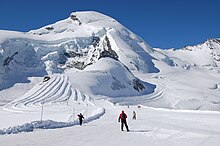
Skiing, snowboarding and mountaineering are among the most popular sports in Switzerland, the nature of the country being particularly suited for such activities. Winter sports are practiced by the natives and tourists since the second half of the 19th century with the invention of bobsleigh in St. Moritz. The first world ski championships were held in Mürren (1931) and St. Moritz (1934). The latter town hosted the second Winter Olympic Games in 1928 and the fifth edition in 1948. Among the most successful skiers and world champions are Pirmin Zurbriggen and Didier Cuche.
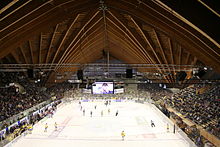
Swiss are fans of football and the national team is nicknamed the 'Nati'. The headquarters of the sport's governing body, the International Federation of Association Football (FIFA), is located in Zürich. Switzerland hosted the 1954 FIFA World Cup, and was the joint host, with Austria, of the Euro 2008 tournament. The Swiss Super League is the nation's professional club league. For the Brasil 2014 World Cup finals tournament, the country's German-speaking cantons will be closely monitored by local police forces to prevent celebrations beyond one hour after matches end. Europe's highest football pitch, at 2,000 metres (6,600 ft) above sea level, is located in Switzerland and is named the Ottmar Hitzfeld Stadium.
Many Swiss also follow ice hockey and support one of the 12 clubs in the League A, which is the most attended league in Europe. In 2009, Switzerland hosted the IIHF World Championship for the 10th time. It also became World Vice-Champion in 2013. The numerous lakes make Switzerland an attractive place for sailing. The largest, Lake Geneva, is the home of the sailing team Alinghi which was the first European team to win the America's Cup in 2003 and which successfully defended the title in 2007. Tennis has become an increasingly popular sport, and Swiss players such as Martina Hingis, Roger Federer, and most recently, Stanislas Wawrinka have won multiple Grand Slams.

Motorsport racecourses and events were banned in Switzerland following the 1955 Le Mans disaster with exception to events such as Hillclimbing. During this period, the country still produced successful racing drivers such as Clay Regazzoni, Sebastian Buemi, Jo Siffert, Dominique Aegerter and successful World Touring Car Championship driver Alain Menu. Switzerland also won the A1GP World Cup of Motorsport in 2007–08 with driver Neel Jani. Swiss motorcycle racer Thomas Lüthi won the 2005 MotoGP World Championship in the 125cc category. In June 2007 the Swiss National Council, one house of the Federal Assembly of Switzerland, voted to overturn the ban, however the other house, the Swiss Council of States rejected the change and the ban remains in place.
Traditional sports include Swiss wrestling or "Schwingen". It is an old tradition from the rural central cantons and considered the national sport by some. Hornussen is another indigenous Swiss sport, which is like a cross between baseball and golf. Steinstossen is the Swiss variant of stone put, a competition in throwing a heavy stone. Practiced only among the alpine population since prehistoric times, it is recorded to have taken place in Basel in the 13th century. It is also central to the Unspunnenfest, first held in 1805, with its symbol the 83.5 kg stone named Unspunnenstein.
Cuisine
Main article: Swiss cuisine
The cuisine of Switzerland is multifaceted. While some dishes such as fondue, raclette or rösti are omnipresent through the country, each region developed its own gastronomy according to the differences of climate and languages. Traditional Swiss cuisine uses ingredients similar to those in other European countries, as well as unique dairy products and cheeses such as Gruyère or Emmental, produced in the valleys of Gruyères and Emmental. The number of fine-dining establishments is high, particularly in western Switzerland.
Chocolate had been made in Switzerland since the 18th century but it gained its reputation at the end of the 19th century with the invention of modern techniques such as conching and tempering which enabled its production on a high quality level. Also a breakthrough was the invention of solid milk chocolate in 1875 by Daniel Peter. The Swiss are the world's largest consumers of chocolate.
The most popular alcoholic drink in Switzerland is wine. Switzerland is notable for the variety of grapes grown because of the large variations in terroirs, with their specific mixes of soil, air, altitude and light. Swiss wine is produced mainly in Valais, Vaud (Lavaux), Geneva and Ticino, with a small majority of white wines. Vineyards have been cultivated in Switzerland since the Roman era, even though certain traces can be found of a more ancient origin. The most widespread varieties are the Chasselas (called Fendant in Valais) and Pinot noir. The Merlot is the main variety produced in Ticino.
See also
Notes
- De jure "federal city"; de facto capital. Due to historical federalist sensibilities, Swiss law does not designate a formal capital; and some federal institutions such as courts are located in other cities.
- The traditional date of the Rütlischwur was 1307 (reported by Aegidius Tschudi in the 16th century). The date of the Federal Charter of 1291 was selected in 1891 for the official celebration of the "Confederacy's 600th anniversary".
- Swiss Standard German spelling and pronunciation. The Swiss German name is sometimes spelled as Schwyz or Schwiiz Template:IPA-de. Schwyz is also the standard German (and international) name of one of the Swiss cantons.
- The latter is the common Sursilvan pronunciation.
- There are several definitions. See Geography of Switzerland#Western or Central Europe?.
- As shown in this image, the current members of the council are (as of January 2014, from left to right): Federal Councillor Johann Schneider-Ammann, Federal Councillor Eveline Widmer-Schlumpf, Vice-President Simonetta Sommaruga, President Didier Burkhalter, Federal Councillor Doris Leuthard, Federal Councillor Ueli Maurer, Federal Councillor Alain Berset and Federal Chancellor Corina Casanova
- Since 1999, an initiative can also be in the form of a general proposal to be elaborated by Parliament, but because it is considered less attractive for various reasons, this form of initiative has yet to find any use.
- That is a majority of 23 cantonal votes, because the result of the popular vote in the six traditional half-cantons each counts as half the vote of one of the other cantons.
- In 2008, the ETH Zurich was ranked 15th in the field Natural Sciences and Mathematics by the Shanghai Academic Ranking of World Universities and the EPFL in Lausanne was ranked 18th in the field Engineering/Technology and Computer Sciences by the same ranking.
References
- ^ Holenstein, André (2012). "Die Hauptstadt existiert nicht" (PDF). http://www.kommunikation.unibe.ch (scientific article). UniPress (in German) (UniPress 152: Die Hauptstatdtregion). Berne: University of Berne: 16–19. Retrieved 27 March 2014.
Als 1848 ein politisch-administratives Zentrum für den neuen Bundesstaat zu bestimmen war, verzichteten die Verfassungsväter darauf, eine Hauptstadt der Schweiz zu bezeichnen und formulierten stattdessen in Artikel 108: «Alles, was sich auf den Sitz der Bundesbehörden bezieht, ist Gegenstand der Bundesgesetzgebung.» Die Bundesstadt ist also nicht mehr und nicht weniger als der Sitz der Bundesbehörden.
{{cite journal}}: External link in|website= - Federal Constitution, article 4, "National languages" : National languages are German, French, Italian and Romansh; Federal Constitution, article 70, "Languages", paragraph 1: The official languages of the Confederation are German, French and Italian. Romansh shall be an official language for communicating with persons of Romansh language.
- A solemn declaration of the Tagsatzung declared the Federal Constitution adopted on 12 September 1848. A resolution of the Tagsatzung of 14 September 1848 specified that the powers of the institutions provided for by the 1815 Federal Treaty would expire at the time of the constitution of the Federal Council, which took place on 16 November 1848.
- "Recent monthly and quarterly figures: provisional data". Population and Households Statistics (STATPOP) (official website). Neuchâtel, Switzerland: Swiss Federal Statistical Office, Swiss Confederation. Retrieved 24 March 2015.
- "Population - Key figures: Main indicators" (official website). Neuchâtel, Switzerland: Swiss Federal Statistical Office, Swiss Confederation. Retrieved 24 March 2015.
- ^ "Switzerland". International Monetary Fund. Retrieved 2 November 2014.
- "Gini coefficient of equivalised disposable income (source: SILC)". Eurostat Data Explorer. Retrieved 13 August 2013.
- "2014 Human Development Report" (PDF). 14 March 2013. pp. 21–25. Retrieved 27 July 2014.
- Thomas Fleiner, Alexander Misic, Nicole Töpperwien, Swiss Constitutional Law, p. 28, Kluwer Law International
- Constitutional Patriotism and Exclusion: the Swiss Case euroculturemaster.org. Retrieved on 30 July 2009
- ^ Attention: This template ({{cite doi}}) is deprecated. To cite the publication identified by doi:10.1017/S0010417598001686, please use {{cite journal}} (if it was published in a bona fide academic journal, otherwise {{cite report}} with
|doi=10.1017/S0010417598001686instead. - "Switzerland is 'world's happiest' country in new poll". BBC News. 24 April 2015. Retrieved 24 April 2015.
- "US is still by far the richest country, China fastest growing". Digitaljournal.com. Retrieved 8 November 2010.
- Franc's rise puts Swiss top of rich list Simon Bowers, guardian.co.uk, Wednesday 19 October 2011
- "Swiss and German cities dominate ranking of best cities in the world". Citymayors.com. 28 April 2009. Retrieved 29 April 2010.
- OED Online Etymology Dictionary etymonline.com. Retrieved on 25 June 2009
- Room, Adrian (2003) Placenames of the World. London: MacFarland and Co., ISBN 0-7864-1814-1.
- Switzerland, the Catholic Encyclopedia newadvent.org. Retrieved on 26 January 2010
- On Schwyzers, Swiss and Helvetians, Federal Department of Home Affairs, admin.ch.
- Züritütsch, Schweizerdeutsch (p. 2) schweizerdeutsch.ch. Retrieved on 26 January 2010
- Kanton Schwyz: Kurzer historischer Überblick sz.ch. Retrieved on 26 January 2010
- Marco Marcacci, Confederatio helvetica (2002), Historical Lexicon of Switzerland.
- Helvetia in German, French and Italian in the online Historical Dictionary of Switzerland.
- ^ History. swissworld.org. Retrieved on 27 June 2009
- Switzerland's Roman heritage comes to life swissinfo.ch
- ^ Switzerland history Nationsencyclopedia.com. Retrieved on 27 November 2009
- ^ History of Switzerland Nationsonline.org. Retrieved on 27 November 2009
- Schwabe & Co.: Geschichte der Schweiz und der Schweizer, Schwabe & Co 1986/2004. ISBN 3-7965-2067-7 Template:De icon
- ^ "A Brief Survey of Swiss History". admin.ch. Archived from the original on 26 June 2009. Retrieved 22 June 2009.
{{cite web}}: Unknown parameter|deadurl=ignored (|url-status=suggested) (help) - Swiss border ("Les principales rectifications postérieures à 1815 concernent la vallée des Dappes en 1862 (frontière Vaud-France, env. 7,5 km2), la valle di Lei en 1952 (Grisons-Italie, 0,45 km2), l'Ellhorn en 1955 (colline revendiquée par la Suisse pour des raisons militaires, Grisons-Liechtenstein) et l'enclave allemande du Verenahof dans le canton de Schaffhouse en 1967.") in German, French and Italian in the online Historical Dictionary of Switzerland.. It should be noticed that in valle di Lei Italy got in exchange a territory of the same area. See here
- Bundesstadt in German, French and Italian in the online Historical Dictionary of Switzerland.
- Tunnel Vision: Switzerland's AlpTransit Gotthard Tunnel inboundlogistics.com. Retrieved on 24 April 2010
- Histoire de la Suisse, Éditions Fragnière, Fribourg, Switzerland
- Lenin and the Swiss non-revolution swissinfo.ch. Retrieved on 25 January 2010
- Urner, Klaus (2001) Let's Swallow Switzerland, Lexington Books, pp. 4, 7, ISBN 0739102559.
- ^ Book review: Target Switzerland: Swiss Armed Neutrality in World War II, Halbrook, Stephen P. stonebooks.com. Retrieved on 2 December 2009
- Asylum in German, French and Italian in the online Historical Dictionary of Switzerland.
- Switzerland, National Socialism and the Second World War. Final Report of the Independent Commission of Experts Switzerland, Pendo Verlag GmbH, Zürich 2002, ISBN 3-85842-603-2, p. 498.
- Switzerland, National Socialism and the Second World War. Final Report of the Independent Commission of Experts Switzerland, Pendo Verlag GmbH, Zürich 2002, ISBN 3-85842-603-2, p. 521.
- 7.4 States Formerly Possessing or Pursuing Nuclear Weapons Retrieved 6 March 2014
- Westberg, Gunnar (9 October 2010). "Swiss Nuclear Bomb". International Physicians for the Prevention of Nuclear War. Retrieved 6 March 2014.
- ^ Country profile: Switzerland. UK Foreign and Commonwealth Office (29 October 2012).
- ^ "Swiss Geography". swissworld.org. Presence Switzerland, Federal Department of Foreign Affairs. Retrieved 12 October 2014.
- "map.search.ch" (online map). Map of Switzerland with route planner. Cartography by TomTom, swisstopo, osm. search.ch / Tamedia. Retrieved 27 March 2015.
- "STAT-TAB: Die interaktive Statistikdatenbank" (in German and French). Neuchâtel, Switzerland: Swiss Federal Statistical Office. Retrieved 12 October 2014.
- "Map Gallery Switzerland: Physical Geography of Switzerland". Neuchâtel, Switzerland: Swiss Federal Statistical Office. Retrieved 12 October 2014.
- ^ "Swiss Climate". Swiss Federal Office of Meteorology and Climatology MeteoSwiss, Swiss Federal Department of Home Affairs FDHA, Swiss Confederation. Retrieved 12 October 2014.
- ^ "Swiss climate maps". Swiss Federal Office of Meteorology and Climatology MeteoSwiss, Swiss Federal Department of Home Affairs FDHA, Swiss Confederation. Retrieved 12 October 2014.
- "Swiss Alps Jungfrau-Aletsch". UNESCO World Heritage Centre. 2007. Retrieved 27 March 2015.
- "Environment: Impact of climate change". swissworld.org. Presence Switzerland, Federal Department of Foreign Affairs. Retrieved 12 October 2014.
- "2014 Environmental Performance Index". http://epi.yale.edu/epi. Yale Center for Environmental Law & Policy, Yale University, and Center for International Earth Science Information Network, Columbia University. 2014. Retrieved 12 October 2014.
{{cite web}}: External link in|website= - ^ Political System admin.ch, Retrieved on 22 June 2009
- "Political System". Federal Department of Foreign Affairs.
- The Judiciary: The Federal Supreme Court ch.ch. Retrieved on 15 December 2009
- ^ Cantons. ch.ch. Retrieved on 15 December 2009
- Kaufmann, Bruno (18 May 2007) How direct democracy makes Switzerland a better place. telegraph.co.uk. Retrieved on 4 December 2009
- Tremblay, R. C. et al. (2004) Mapping the Political Landscape. Toronto: Nelson, ISBN 017642413X.
- Banks, Arthur (2006). Political Handbook of The World 2005–2006. Washington: Cq Press, ISBN 1568029527
- Enclaves of the world enclaves.webs.com. Retrieved on 15 December 2009
- ^ Neutrality and isolationism swissworld.org, Retrieved on 23 June 2009
- "Switzerland – Country history and economic development". nationsencyclopedia.com. Retrieved 12 December 2009.
- Henri Dunant, the Nobel Peace Prize 1901 nobelprize.org. Retrieved on 2 December 2009
- Sports directory if-sportsguide.ch. Retrieved on 25 January 2010
- An initiative to abandon this practice has been launched on 4 September 2007, and supported by GSoA, the Green Party of Switzerland and the Social Democratic Party of Switzerland as well as other organisations which are listed at Tragende und unterstützende Organisationen. schutz-vor-waffengewalt.ch
- "Militärdiestpflicht" (in German, French, and Italian). Swiss Federal Department of Defence, Civil Protection and Sport. Retrieved 15 January 2014.
- "Zwei Drittel der Rekruten diensttauglich (Schweiz, NZZ Online)". Retrieved 23 February 2009.
- Die Armee in Zahlen – Truppenbestände. www.vbs.admin.ch (in German)
- As context, according to Edwin Reischauer, "To be neutral you must be ready to be highly militarized, like Switzerland or Sweden." – see Chapin, Emerson. "Edwin Reischauer, Diplomat and Scholar, Dies at 79," New York Times. 2 September 1990.
- Volksabstimmung vom 26. November 1989 admin.ch. Retrieved on 25 January 2010
- L'évolution de la politique de sécurité de la Suisse ("Evolution of Swiss Security Policies") by Manfred Rôsch, NATO.int
- Volksinitiative 'für eine glaubwürdige Sicherheitspolitik und eine Schweiz ohne Armee (in German) admin.ch. Retrieved on 7 December 2009
- "Watches". Swissworld.org. Retrieved 28 February 2012.
- Credit Suisse: Global wealth has soared 14% since 2010 to USD 231 trillion with the strongest growth in emerging markets. Credit Suisse.
- Table 2: Top 10 countries with the highest average wealth per adult in 2011. Credit Suisse.
- Credit Suisse Research Institute (9 October 2013). "Global Wealth Reaches New All-Time High". The Financialist. Credit Suisse. Retrieved 10 October 2013.
- 2012 Index of Economic Freedom: Switzerland heritage.org. Retrieved on 25 January 2011
- ^ "CIA – The World Factbook". Cia.gov. Retrieved 28 April 2013.
- "World Economic Forum – Global Competitiveness Report". Weforum.org. Retrieved 29 April 2010.
- The Innovation Union's performance scoreboard for Research and Innovation 2010. Maastricht Economic and social Research and training centre on Innovation and Technology, 1 February 2011.
- ^ Western Europe. Routledge. 2002. pp. 645–646. ISBN 1-85743-152-9.
- Comparative Agendas accessed 12 July 2013
- The most powerful cities in the world citymayors.com. Retrieved on 27 April 2012
- "Six Swiss companies make European Top 100". swissinfo.ch. 18 October 2008. Retrieved 22 July 2008.
- ^ Swiss Statistical Yearbook 2008 by Swiss Federal Statistical Office
- "Trade Unions – Switzerland". Retrieved 17 December 2012.
- Swiss jobless reach 12-year high – a mere 4.4 pct. Associated Press (8 January 2010).
- "The Conference Board Total Economy Database – Output, Labor, and Labor Productivity, 1950 – 2012" (Excel). The Conference Board. January 2013. GDP per Hour, in 2012 EKS$.
- ^ Policy Brief: Economic Survey of Switzerland, 2007 (326 KiB), OECD
- Economic Policy Reforms: Going for Growth 2008 – Switzerland Country Note. Organisation for Economic Co-operation and Development (OECD), 2008, ISBN 978-92-64-04284-1
- Federal Department of Finance. (2012/1). p. 82.
- http://www.efv.admin.ch/d/downloads/finanzberichterstattung/budget/kontext/Praes_Budget-2014_FP2015-17.pdf
- Domestic purchasing power of wages (68 KiB)
- Switzerland tops in buying power. Swiss News (1 May 2005).
- Want the world's best wages? Move to Switzerland reuters.com. Retrieved on 14 January 2010.
- ^ The Swiss education system swissworld.org, Retrieved on 23 June 2009
- ETH Zurich (Swiss Federal Institute of Technology) topouniversities.com. Retrieved on 30 April 2010
- Top.Universities Retrieved on 30 April 2010
- "Shanghai Ranking 2008 Top 100 world universities in Natural Sciences and Mathematics". Ed.sjtu.edu.cn. Retrieved 2 November 2010.
- Kim Thomas (1 October 2014). "Why does Switzerland do so well in university rankings?". The Guardian. London. Retrieved 12 October 2014.
- "Chart C3.1. Percentage of foreign students in tertiary education (1998, 2003) in Education at a Glance, OECD indicators 2005 - Executive Summary" (PDF). http://www.oecd.org/edu/eag2005 (Study). OECD. 2005. p. 44. Retrieved 22 December 2013.
{{cite web}}: External link in|website= - Education at Glance 2005 by the OECD: Percentage of foreign students in tertiary education.
- "Graduate Institute of International Studies Geneva Overview | Study Abroad Programs". Studyihub.com. 13 September 2010. Retrieved 28 April 2013.
- "e-Perspectives, Kendra Magraw ('10) Accepted at Geneva's Prestigious IHEID – U of MN Law School". Law.umn.edu. Retrieved 28 April 2013.
- Snygg, John (2011). A New Approach to Differential Geometry Using Clifford's Geometric Algebra. Springer. p. 38. ISBN 978-0-8176-8282-8.
- Mueller, Roland. "Swiss Nobel Prize Winners / Nobel Prize Winners in Switzerland". Muellerscience.com. Retrieved 29 May 2011.
- Nobel prizes in non-science categories included.
- "Mueller Science – Spezialitaeten: Schweizer Nobelpreisträger". Retrieved 31 July 2008.
- info.cern.ch Retrieved on 30 April 2010
- "CERN - the largest laboratory in the world www.swissworld.org". Swissworld.org. Retrieved 29 April 2010.
- Oerlikon Space at a Glance. www.oerlikon.com
- "5 Years on Mars". Maxonmotor.ch. 4 January 2004.
- Prof Clive Church (May 2003). "The contexts of Swiss opposition to Europe". Sussex European Institute. p. 12. Archived from the original (PDF, 124 KiB) on 26 November 2009. Retrieved 13 June 2008.
- "GDP growth (annual %)". World Bank. Retrieved 13 August 2013.
- "Volksinitiative "Ja zu Europa!"" (PDF, 1.1 MiB) (in German). BFS/OFS/UST. 13 February 2003. Retrieved 15 June 2008.
{{cite web}}: Unknown parameter|trans_title=ignored (|trans-title=suggested) (help) - "Volksinitiative "Ja zu Europa!", nach Kantonen. (Initiative "Yes to Europe!" by Canton)" (XLS) (in German). BFS/OFS/UST. 16 January 2003. Retrieved 15 June 2008.
- "Bilateral agreements Switzerland-EU". www.europa.admin.ch (web page). Swiss Directorate for European Affairs DEA, Federal Department of Foreign Affairs FDFA. Retrieved 8 May 2014.
- "Institutional issues". www.europa.admin.ch (web page). Swiss Directorate for European Affairs DEA, Federal Department of Foreign Affairs FDFA. Retrieved 8 May 2014.
- Switzerland and the European Union europa.admin.ch. Retrieved on 25 January 2010
- Switzerland in Schengen: end to passport checks euronews.net. Retrieved on 25 January 2010
- "Abstimmungen – Indikatoren, Abstimmung vom 9. Februar 2014: Initiative "Gegen Masseneinwanderung"" (web page) (in German and or French). Swiss Federal Statistical Office, Neuchâtel 2014. 9 February 2014. Retrieved 20 April 2014.
{{cite web}}: CS1 maint: unrecognized language (link) - Swiss voters back limit on immigration Herald-Tribune (The Associated Press). 9 February 2014. Retrieved 10 February 2014.
- Niklaus Nuspliger (Febr.2014). «Der Ball ist im Feld der Schweiz» (in German). Neue Zürcher Zeitung NZZ.ch. Retrieved 10 February 2014.
- "Vote No. 502 – Summary" (in German). 18 May 2003.
- "Vote No. 501 – Summary" (in German). 18 May 2003.
- "Federal government energy research". 16 January 2008.
- "Switzerland to Phase Out Nuclear Energy; E.U. Strikes Deal on 'Stress Tests'". 25 May 2011.
- "Verkehrsleistungen – Daten, Indikatoren admin.ch (German)". Bfs.admin.ch. 25 March 2010. Retrieved 29 April 2010.
- Schienenverkehr admin.ch (German)
- Rhaetian Railway in the Albula / Bernina Landscapes unesco.org
- "Switzerland". Xinhua. 1 April 2003.
- anna.aero European Airport Traffic Trends accessed 12 July 2013
- Geneva Airport statistics accessed 12 July 2013
- Swiss sit atop ranking of greenest nations msnbc.com. Retrieved on 2 December 2009
- Party grouping unfccc.int. Retrieved on 2 December 2009
- W3design. "Swiss Recycling". Swissrecycling.ch. Retrieved 29 April 2010.
{{cite web}}: CS1 maint: numeric names: authors list (link) - "2014 Global Green Economy Index" (PDF). Dual Citizen LLC. Retrieved 20 October 2014.
- Stadtreinigung Basel-Stadt—Pricelist bags and stickers
- "Recycling around the world". BBC. 25 June 2005. Retrieved 24 April 2006.
- Richtig Entsorgen (Kanton Basel-Stadt) (1.6 MiB)—Wilde Deponien sind verboten... Für die Beseitigung widerrechtlich deponierter Abfälle wird zudem eine Umtriebsgebühr von Fr. 200.– oder eine Busse erhoben (page 90)
- History of paper manufacturing in German, Retrieved 3 May 2011
- "Population - Key figures, 2012". http://www.bfs.admin.ch (Statistics) (in English, German, French, and or Italian). Neuchâtel: Swiss Federal Statistical Office, 2013. Retrieved 22 December 2013.
{{cite web}}: External link in|website= - ^ "Migration and integration – Data, indicators, Nationality, Foreign permanent resident population by nationality, 2012". http://www.bfs.admin.ch (Statistics) (in English, German, French, and or Italian). Neuchâtel: Swiss Federal Statistical Office, 2013. Retrieved 22 December 2013.
{{cite web}}: External link in|website= - "Migration and integration – Data, indicators, Nationality, Population with an immigration background, Permanent resident population aged 15 or over, by migration status, 2nd quarter 2012". http://www.bfs.admin.ch (Statistics) (in English, German, French, and or Italian). Neuchâtel: Swiss Federal Statistical Office, 2013. Retrieved 22 December 2013.
{{cite web}}: External link in|website= - Definitive report on racism in Switzerland by UN expert humanrights.ch
- "Bevölkerung, Strukturerhebung der eidgenössischen Volkszählung 2011: Bevölkerung nach Sprache und Religion, Ständige Wohnbevölkerung ab 15 Jahren nach Hauptsprachen, 2011" (XLS). http://www.bfs.admin.ch (Statistics) (in German, French, and or Italian). Neuchâtel: Swiss Federal Statistical Office, 2013. 30 May 2013. Retrieved 22 December 2013.
{{cite web}}: External link in|website= - "Bevölkerung, Strukturerhebung der eidgenössischen Volkszählung 2011: Bevölkerung nach Sprache und Religion, Ständige Wohnbevölkerung ab 15 Jahren nach zuhause gesprochenen Sprachen, 2011" (XLS). http://www.bfs.admin.ch (Statistics) (in German, French, and or Italian). Neuchâtel: Swiss Federal Statistical Office, 2013. 30 May 2013. Retrieved 22 December 2013.
{{cite web}}: External link in|website= - The Parliamentary Services parlament.ch. Retrieved on 25 January 2010
- ^ "Dialekte" (in German). Historisches Lexikon der Schweiz. Retrieved 15 August 2013.
- "SBB: Billette – OnlineTicket". Mct.sbb.ch. Retrieved 29 April 2010.
- ^ Duden Schweizerhochdeutsch (in German). Duden. 2012. ISBN 978-3-411-70417-0. Retrieved 28 October 2013.
- Michael G. Clyne (1992). Pluricentric Languages: Differing Norms in Different Nations. Walter de Gruyter. p. 164. ISBN 978-3-11-012855-0. Retrieved 7 September 2013.
- Minorities and bilingualism swissworld.org. Retrieved on 25 January 2010
- "Patients are very satisfied with»" [Patienten mit «Spital Schweiz» sehr zufrieden «Hospital Switzerland] (in German). Berne, Switzerland: ANQ Nationaler Verein für Qualitätsentwicklung in Spitälern und Kliniken. 5 November 2014. Retrieved 1 April 2015.
Die Antworten erreichten auf einer Skala von 1 bis 10 durchschnittliche Werte zwischen 9 und 9,4.
- "Zufriedenheit durch Vertrauen: Kurzbericht zur grossen Ärztestudie" (PDF) (in German). Berne, Switzerland: gfs.bern, 20 Minuten Online, comparis.ch. 10 October 2012. p. 9. Retrieved 9 April 2015.
Mehrheitliche 91 Prozent sind mit "ihrem" Hausarzt mehr oder weniger dezidiert zufrieden.
- Rico Kütscher (28 June 2014). "Kundenzufriedenheit: Krankenkassen sollten Effizienz und Image verbessern". Neue Zürcher Zeitung, NZZ (in German). Zürich, Switzerland. Retrieved 8 April 2015.
Wie es um die Kundenzufriedenheit in der Branche generell steht, zeigt eine 2013 im Auftrag von «K-Tipp» durchgeführte repräsentative Umfrage unter Versicherten, die in den vergangenen zwei Jahren Leistungen von ihrer Krankenkasse in Anspruch genommen haben. Beim Testsieger Concordia waren rund 73% der Versicherten «sehr zufrieden». Bei grossen Krankenkassen wie der CSS und Helsana betrug dieser Anteil 70% beziehungsweise 63%. Groupe Mutuel erreichte rund 50%, und die Billigkasse Assura kam auf 44%. Dies illustriert, dass die Zufriedenheit durchaus hoch ist – dass es aber auch Potenzial für Effizienzsteigerungen bei Krankenkassen gibt.
- "Components of population change – Data, indicators: Deaths, mortality and life expectancy". Swiss Federal Statistical Office, Neuchâtel 2013. 2012. Retrieved 21 November 2013.
- "The Human Capital Report, Insight Report" (PDF). World Economic Forum. 2013. pp. 480, 12, 14, 478–481. Retrieved 21 November 2013.
- "OECD.StatExtracts, Health, Health Status, Life expectancy, Total population at birth, 2011" (Online Statistics). http://stats.oecd.org/. OECD's iLibrary. 2013. Retrieved 22 November 2013.
{{cite web}}: External link in|website= - "Statistical Data on Health and Accident Insurance" (PDF). Swiss Federal Office of Public Health (FOPH) 2012 Edition (Flyer, A4, 2 pages). 19 December 2012. p. 2. Retrieved 21 November 2013.
- ^ OECD and WHO survey of Switzerland's health system oecd.org. Retrieved on 29 June 2009
- Where people live swissworld.org. Retrieved on 26 June 2009
- ^ Städte und Agglomerationen unter der Lupe admin.ch. Retrieved on 26 June 2009
- Swiss countryside succumbs to urban sprawl swissinfo.ch. Retrieved on 30 June 2009
- Enquête représentative sur l'urbanisation de la Suisse (Pronatura) gfs-zh.ch. Retrieved on 30 June 2009
- Swiss plateau swissworld.org. Retrieved on 29 June 2009
- Quality of living mercer.com. Retrieved on 26 June 2009
- "Die Kirchensteuern August 2013" (PDF). http://www.estv.admin.ch (Document) (in German (French and or Italian)). Berne: Schweizerische Steuerkonferenz SSK, Swiss Federal Tax Administration FTA, Federal Depertment of Finance FDF. 2013. Retrieved 5 April 2014.
{{cite web}}: External link in|website= - "Evangelical Churches Growing Fast in Switzerland". Christian Post. Retrieved 7 June 2015.
- Volksabstimmung vom 2. März 1980 admin.ch. Retrieved on 2010
- Swiss culture swissworld.org. Retrieved on 1 December 2009
- European Year of Intercultural Dialogue Dr Michael Reiterer. Retrieved on 1 December 2009
- Switzerland: culture traveldocs.com. Retrieved on 1 December 2009
- Museums swissworld.org. Retrieved on 2 December 2009
- Lucerne Festival nytimes.com. Retrieved on 15 December 2010
- Montreux Jazz Festival Retrieved on 26 August 2013
- Film festivals swissworld.org. Retrieved on 2 December 2009
- Mountains and hedgehogs. swissworld.org. Retrieved on 1 December 2009
- Folk music swissworld.org. Retrieved on 2 December 2009
- Culture of Switzerland europe-cities.com. Retrieved on 14 December 2009
- Art in literature cp-pc.ca. Retrieved on 14 December 2009
- From Encyclopædia Britannica Eleventh Edition, Swiss literature
- ^ Literature swissworld.org, Retrieved on 23 June 2009
- ^ Press and the media ch.ch. Retrieved on 25 June 2009
- ^ Press in Switzerland pressreference.com. Retrieved on 25 June 2009
- Sport in Switzerland europe-cities.com. Retrieved on 14 December 2009
- A brief history of bobsleigh fibt.com. Retrieved on 2 November 2009
- Our Foreign Staff (8 June 2014). "World Cup 2014: Swiss police allow celebrating – but only for an hour". The Telegraph. Telegraph Media Group Limited. Retrieved 9 June 2014.
- "The world's most amazing football pitches – in pictures". The Guardian. Guardian News and Media Limited. 8 June 2014. Retrieved 9 June 2014.
- Geering. "Hockeyarenas.net". Hockeyarenas.net. Retrieved 3 November 2011.
- "IIHF World Championships 2009 official website". Iihf.com. 10 May 2009. Retrieved 29 April 2010.
- Roger Federer's Grand Slam Titles sportsillustrated.cnn.com. Retrieved on 14 June 2010
- "Switzerland lifts ban on motor racing". GrandPrix.com & DueMotori.com. 6 June 2007. Retrieved 23 September 2008.
- "Swiss vote against racing". Grandprix.com. Inside F1, Inc. 10 October 2007. Retrieved 13 June 2014.
- Hornussen swissroots.org. Retrieved on 25 January 2010
- Tradition and history interlaken.ch. Retrieved on 25 January 2010
- Zürcher Geschnetzeltes Zürcher Geschnetzeltes, engl.: sliced meat Zürich style
- Flavors of Switzerland theworldwidegourmet.com. Retrieved on 24 June 2009
- Michelin Guide Switzerland 2010 attests to the high quality of gourmet cooking with one new 2 star restaurant and 8 new one star Press information, Michelin. Retrieved on 14 December 2009
- Swiss region serves up food with star power usatoday.com. Retrieved on 14 December 2009
- Chocolate swissworld.org. Retrieved on 24 June 2009
- Swiss Chocolate germanworldonline.com (4 December 2009). Retrieved on 14 June 2010
- Wine-producing Switzerland in short swisswine.ch. Retrieved on 24 June 2009
- Table 38. Top wine consuming nations per capita, 2006 winebiz.com. Retrieved on 14 June 2010
Bibliography
- Church, Clive H. (2004) The Politics and Government of Switzerland. Palgrave Macmillan. ISBN 0-333-69277-2.
- Dalton, O.M. (1927) The History of the Franks, by Gregory of Tours. Oxford: The Clarendon Press.
- Fahrni, Dieter. (2003) An Outline History of Switzerland. From the Origins to the Present Day. 8th enlarged edition. Pro Helvetia, Zürich. ISBN 3-908102-61-8
- von Matt, Peter: Das Kalb vor der Gotthardpost. Zur Literatur und Politik in der Schweiz. Carl Hanser Verlag, München, 2012, ISBN 978-3-446-23880-0, S. 127–138.
- Historical Dictionary of Switzerland (2002–). Published electronically and in print simultaneously in three national languages of Switzerland.
External links
- Government
- The Federal Council
- The Federal Authorities of the Swiss Confederation
- Swissworld.org, Switzerland's information portal
- Swiss Statistics at the Swiss Federal Statistical Office.
- Practical informations
- Reference
- Switzerland at UCB Libraries GovPubs.
- Switzerland entry at Encyclopædia Britannica.
- Template:Dmoz
- Switzerland profile from the BBC News.
- "Switzerland". The World Factbook (2025 ed.). Central Intelligence Agency.
- Geography
 Wikimedia Atlas of Switzerland
Wikimedia Atlas of Switzerland- Federal Office of Topography
- Searchable interactive map (search.ch)
 Geographic data related to Switzerland at OpenStreetMap
Geographic data related to Switzerland at OpenStreetMap
- Travel
- History
- Template:De icon Template:Fr icon Template:It icon Historical Dictionary of Switzerland
- Swiss American Historical Society
- Languages
- swiss-linguistics.com, a portal on current linguistic research in Switzerland.
- News media
- Daily newspapers
- swissinfo.ch, Swiss News – Worldwide
- Education
- Science, research, and technology
- State Secretariat for Education and Research, SER
- The Swiss Portal for Research and Innovation (private source).
46°50′00″N 8°20′00″E / 46.83333°N 8.33333°E / 46.83333; 8.33333
Portal:Categories:
- Switzerland
- Countries in Europe
- Central Europe
- Western Europe
- Federal countries
- French-speaking countries and territories
- German-speaking countries and territories
- Italian-speaking countries and territories
- Landlocked countries
- Liberal democracies
- Member states of La Francophonie
- Member states of the United Nations

